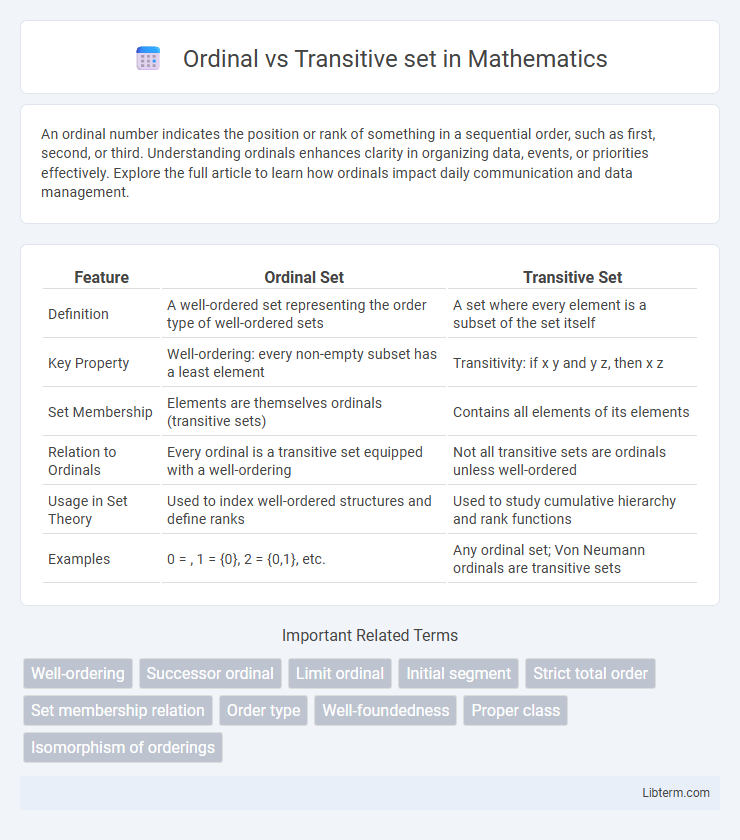An ordinal number indicates the position or rank of something in a sequential order, such as first, second, or third. Understanding ordinals enhances clarity in organizing data, events, or priorities effectively. Explore the full article to learn how ordinals impact daily communication and data management.
Table of Comparison
| Feature | Ordinal Set | Transitive Set |
|---|---|---|
| Definition | A well-ordered set representing the order type of well-ordered sets | A set where every element is a subset of the set itself |
| Key Property | Well-ordering: every non-empty subset has a least element | Transitivity: if x y and y z, then x z |
| Set Membership | Elements are themselves ordinals (transitive sets) | Contains all elements of its elements |
| Relation to Ordinals | Every ordinal is a transitive set equipped with a well-ordering | Not all transitive sets are ordinals unless well-ordered |
| Usage in Set Theory | Used to index well-ordered structures and define ranks | Used to study cumulative hierarchy and rank functions |
| Examples | 0 = , 1 = {0}, 2 = {0,1}, etc. | Any ordinal set; Von Neumann ordinals are transitive sets |
Introduction to Ordinal and Transitive Sets
Ordinal sets represent well-ordered collections where every element has a unique position, essential in set theory for defining order types and transfinite sequences. Transitive sets contain elements that are subsets of the set itself, providing a foundation for constructing ordinals and ensuring closure under membership. Understanding the distinction and interaction between ordinal and transitive sets is fundamental for exploring hierarchical structures in mathematical logic.
Defining Ordinal Sets in Set Theory
Ordinal sets in set theory are well-ordered sets that intrinsically represent order types of well-ordered structures, where every element is defined as the set of all smaller ordinals. Unlike transitive sets, which contain all elements of their members, ordinals require transitivity and well-ordering, making them fundamental in classifying order types and transfinite induction. The von Neumann definition characterizes each ordinal as the set of all previous ordinals, ensuring a strict hierarchy and enabling rigorous treatment of infinite sequences.
The Concept of Transitive Sets Explained
A transitive set is a set where every element is also a subset of the set, meaning if an element belongs to the set, all elements of that element are also included. This concept is crucial in set theory as transitive sets form the foundation for defining ordinals, where each ordinal is a transitive set well-ordered by set membership. Understanding transitive sets helps distinguish them from arbitrary sets and emphasizes their role in constructing hierarchical structures in mathematics.
Key Properties of Ordinal Sets
Ordinal sets are well-ordered sets characterized by every non-empty subset having a least element, ensuring a strict total order that is transitive and antisymmetric. Key properties include transitivity, where each element is a subset of the ordinal, and well-foundedness, preventing infinite descending sequences. These properties distinguish ordinal sets from general transitive sets, emphasizing structure crucial in set theory and foundational mathematics.
Fundamental Properties of Transitive Sets
Transitive sets are characterized by the property that every element is also a subset, ensuring that membership chains are linearly ordered and well-founded. Unlike ordinals, which are well-ordered transitive sets, transitive sets do not require a strict ordering but preserve the foundational property that elements' elements also belong to the set. This self-contained membership structure facilitates the construction of cumulative hierarchies fundamental to set theory.
Differences Between Ordinal and Transitive Sets
Ordinal sets are well-ordered sets that represent positions or ranks in a sequence, characterized by a strict order where every element has a unique successor except the maximum. Transitive sets, on the other hand, are sets where every element is also a subset of the set, ensuring that membership relations are preserved throughout. The key difference lies in ordinals imposing a well-order structure while transitive sets emphasize the hereditary membership property fundamental to set-theoretic hierarchy.
Relationship Between Ordinal and Transitive Sets
Ordinal sets are well-ordered transitive sets where each element is also a subset, ensuring a strict hierarchical structure. Transitive sets contain all elements of their elements, creating a foundational framework that supports the definition of ordinals. The relationship between ordinal and transitive sets lies in ordinals being specific transitive sets arranged by a well-ordering relation, which allows them to represent positions or ranks in a well-defined sequence.
Examples Illustrating Ordinal and Transitive Sets
An ordinal set such as o, the set of all natural numbers, is transitive because every element is also a subset of the set, exemplified by 0 o and 0 o. Another example is the set {, {}, {{}}}, which is transitive since each element is contained within the set in the form of nested subsets, illustrating ordinal properties. Conversely, a non-transitive set like {1, {2}} fails this property because 2 {1, {2}}, showing the distinction between transitive and non-transitive collections.
Applications in Mathematical Logic and Set Theory
Ordinal sets provide a foundational framework for describing well-ordered structures, crucial in proofs involving transfinite induction and recursion within mathematical logic. Transitive sets, which contain all elements of their members, support the construction of cumulative hierarchies essential for the formalization of set theory, particularly in defining von Neumann ordinals. Applications of these concepts are evident in the development of models of Zermelo-Fraenkel set theory (ZF), where transitive sets facilitate the understanding of rank functions and ordinal-indexed stages of the universe V.
Summary and Conclusion
Ordinal sets represent well-ordered collections where every subset has a least element, foundational in defining order types and transfinite sequences. Transitive sets contain all elements of its elements, ensuring closure under membership and playing a crucial role in the cumulative hierarchy of set theory. Understanding the distinction highlights how ordinals provide canonical well-orderings, while transitive sets establish structural frameworks essential for formulating rank and hierarchy concepts in set theory.
Ordinal Infographic

 libterm.com
libterm.com